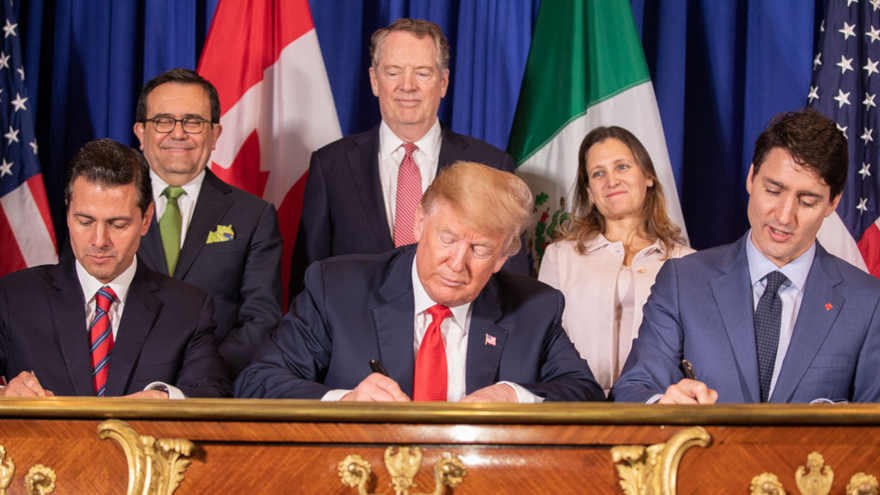3 experts examine USMCA impact after Trump signs trade deal

President Trump is joined by Mexican President Enrique Pena Nieto and Canadian Prime Minister Justin Trudeau at the USMCA signing ceremony Friday in Buenos Aires, Argentina. Photo courtesy of the White House.
President Trump happily signed the new United States-Mexico-Canada Agreement (USMCA) on Friday; a pact that replaced the North American Free Trade Agreement (NAFTA).
And a trio of Cox Automotive experts also shared an upbeat assessment of the actions that might eventually trickle down to auctions and dealerships as new models become used vehicles.
“The USMCA is the largest, most significant, modern and balanced trade agreement in history,” Trump said at the signing event in Buenos Aires, Argentina. “All of our countries will benefit greatly. It is probably the largest trade deal ever made.
“In the United States, the new trade pact will support high-paying manufacturing jobs and promote greater access for American exports across the range of sectors, including our farming, manufacturing and service industries,” he continued.
Trump then honed in on the potential impact in the auto space.
“Under the USMCA, at least 75 percent of our automobiles’ content must be manufactured in North America, and 40 to 45 percent of automobile content must be manufactured by North American high-wage labor in order to gain preferential access to our markets,” Trump said.
“This will help stop auto jobs from going overseas, and it will bring back auto jobs that have already left,” he continued. “Many, many jobs are already planning to come back. Many companies are coming back, and we’re very excited about that.”
After Trump shared his remarks, Cox Automotive distributed the assessment from three of its experts who have been watching the USMCA develop. The rundown began with Cox Automotive chief economist Jonathan Smoke.
“Nearly a quarter of all new vehicles sold in the U.S. are assembled in either Mexico or Canada. And given decades of supply chain evolution based on NAFTA, a substantial portion of the vehicles assembled within the U.S. are dependent on components from Mexico and Canada,” Smoke said.
“With tweaks in labor costs and content rules, costs — and therefore, prices — will likely go up as this agreement becomes law,” he continued.
Smoke did spot some potential turbulence with this new agreement.
“The remaining wild card here is the Section 232, which not only would apply to the roughly 23 percent of vehicles imported into the U.S. from outside of North America, it would also serve as the basis for the penalty for any vehicles that fails the new USMCA content rules,” Smoke said.
“That’s one of the two reasons we believe President Trump will continue to pursue 232, with the other reason being a threat to pressure China, Europe and Japan into better deals,” he continued.
“The USMCA won’t lead to major shifts in the existing production and supply chain for the industry, and that’s a good thing,” Smoke went on to say. “But it will prevent substantial movement away from North America and the U.S. in the future because of the added rules and the potential of a higher Section 232 penalty.”
Cox Automotive senior economist Charlie Chesbrough added his perspective, too, calling Friday’s developments “another important step forward in this process.”
Chesbrough continued with, "Although formal legislative approval by all three countries is still needed and, of late, nothing is guaranteed. Once finally approved, it will be good news for the automotive industry as longer-term strategic sourcing and manufacturing planning in the region can finally resume.
“However, with the steel and aluminum tariffs still in place, trade issues are still having a negative effect on auto maker profitability,” Chesbrough added.
Finally, Autotrader executive analyst Michelle Krebs framed her USMCA commentary in light of what’s also surfaced from General Motors and Ford. GM announced it would be shutting down five manufacturing facilities in the U.S. and Canada that primarily build sedans, while the Blue Oval indicated it’s moving approximately 90 percent of its North American vehicle lineup volume to SUVs, pickup trucks and commercial vehicles by the end of 2020.
“The good news for the auto industry is that forward progress is being made, with a long-term horizon of 16 years. While we won’t fully know until the pact receives legislative approval, the new agreement seems to mostly supports the status quo and won’t force any substantial shift in the established North America manufacturing footprint,” Krebs said.
“Considering announcements made this week by both General Motors and Ford, it’s clear major U.S. auto makers are still struggling with production and capacity issues. This new agreement won’t change that fact,” she added.

 View The Latest Edition
View The Latest Edition

